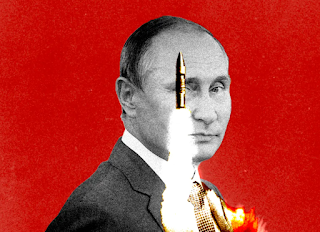Analysts warn that a nuclear conflict is possible as global tensions are shifted by Russia's invasion of Ukraine. Russian President Vladimir Putin is in a vulnerable and unpredictable position as he faces a sluggish economy, growing dissent among his citizens and, now, a potential military defeat.
Citing New Scientist, on February 27, Putin raised the level of Russia's nuclear readiness system by ordering his troops to take on a special combat duty regime.
Patrick Bury of the University of Bath, UK, said the announcement was remarkable even though it was still vague, at odds with the typical nuclear deterrence strategy of acting in a clear and transparent manner as a warning to others.
He and fellow academics and analysts assume that the country is already on level 2 of Russia's four-tier system, given the situation in Ukraine.
But Putin's announcement was widely interpreted as a move from level 1 (standing) to level 2 (ready to take orders to fire). Bury believes the world today is closer to nuclear conflict than at any point since the cold war tensions of the 1980s.
"Putin has stabbed a sleeping giant," he said. "The West has responded massively."
This response has included Western countries sending arms and aid to Ukraine, while stronger-than-expected economic sanctions from around the world piled pressure on Putin.
If Russia's current invasion fails, Putin could be ousted from power or even killed in a coup, which Bury warns is a situation that puts Putin in a corner.
Bury puts the probability of a nuclear explosion as a result of this crisis at 20%, but points out that it need not lead to an all-out nuclear war. Instead, we could see low-power devices being used against the military in Ukraine, or even large devices being detonated at sea just as a show of force.
David Galbreath at the University of Bath says the conflict is about more than just Ukraine: it's a muscle tension in Russia against what Putin sees as a growing threat to cooperation in the European Union and NATO's military alliance.
Galbreath said it was clear in building the invasion that the type of personnel and weapons amassed at the border was the kind that would be deployed to attack Kiev, the Ukrainian capital, overthrow Ukrainian president Volodymyr Zelenskyy and appoint a puppet leader – not what is needed to occupy a country.
If this was the plan, it would have failed. And so we can now see the use of the more powerful military options available to Putin, such as electronic warfare that can knock out enemy surveillance and vehicles, and advanced anti-aircraft missiles that would prevent Ukraine from defending its airspace.
"Nuclear weapons are also possible, but only as a last resort," Galbreath said.
"In terms of military action, I think what we've seen so far is pretty limited. I think they will be heavy next. And I think we need to prepare for much worse victims," said Kenton White at the University of Reading, UK.
White was referring to the Russian military tactic of maskirovka, or disinformation, which the country had used during the invasion. In extreme cases, White said this could extend to false-flag operations, such as the explosion of a small nuclear bomb outside Ukraine's borders, which NATO blames.
"There's a lot of talk about the rationality of action when you talk about nuclear deterrence," White said. "Well, President Putin has his own rationality."
Subscribe Daily Post or Follow Google News to update information quickly, Thank you..!!



